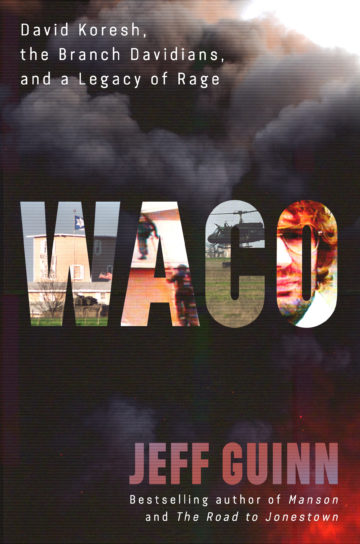Thirty years ago this April 19, TV viewers looked on as Mount Carmel—the sprawling Branch Davidian compound on a bleak stretch of prairie outside Waco—was engulfed in flame and smoke. The destruction of the rickety settlement, familiar after two months of intense media coverage, marked the fiery end of a 51-day siege which left four federal agents and 82 Branch Davidians dead, including 23 children and the group’s messianic leader, David Koresh.

The siege also left troubling questions: How did it all go so badly wrong? Who was to blame? What motivated people of faith—among them a Harvard-trained lawyer, a one-time University of Hawaii Ph.D. student, and a former middle school teacher—to kill and die at the behest of a man authorities portrayed as a delusional “cult” leader, a religious con man?
Jeff Guinn’s new book Waco: David Koresh, the Branch Davidians, and a Legacy of Rage, set for release January 24, explores familiar themes previously aired in government investigations, books (scholarly and for general audiences), articles, survivor memoirs, documentary films, videos, and even a miniseries.
Yet Guinn’s Waco is no mere rehash. The Fort Worth author of books on Charles Manson and Jim Jones mines three decades of investigation and scholarship to tell a complex story of motivations, misdeeds, misunderstandings, and missed opportunities. Guinn interviewed survivors and scholars, and most significantly, former federal agents who spoke publicly for the first time about the siege. The result is a compelling, well-researched, and even-handed account of a tragedy that still haunts our political culture today.
Early on February 28, 1993, agents of the Bureau of Alcohol, Tobacco, and Firearms and Explosives (ATF), acting on information that Koresh and his followers were stockpiling illegal weapons, raided Mount Carmel. The Branch Davidians had been tipped off and were waiting, armed and ready for what they believed was the biblically prophesied apocalyptic battle with the evil forces of “Babylon.” The ensuing two-hour firefight left four ATF agents and five Branch Davidians dead. The FBI then took control. Despite seven weeks of negotiations and pressure, Koresh and his flock wouldn’t budge. Finally, on April 19, FBI armored vehicles knocked holes in the flimsy walls and launched CS tear gas into the compound. For reasons that are still debated (and remain unresolved in Waco), fire broke out, rapidly destroying the compound. Koresh and most of his followers lay dead in the rubble.
A few months later, Molly Ivins wrote in the Texas Observer, “If anyone can think of anything good to be said about the law enforcement’s handling of the Branch Davidians … call someone in authority. I can’t think of a single thing.”
“If anyone can think of anything good to be said about the law enforcement’s handling of the Branch Davidians … call someone in authority. I can’t think of a single thing.”—Molly Ivins
Readers of Guinn’s account will likely draw a similar conclusion. It’s clear that the ATF raid was motivated by more than just seizing illegal weapons: with congressional budget hearings looming, officials of the chronically-underfunded agency needed a major operational success to brag about. The planning and execution were severely flawed. ATF leaders went ahead with the “surprise” attack after being told the Branch Davidians knew they were coming. They had no fallback strategy.
For its part, the FBI was plagued by clashes between negotiators working for a peaceful resolution, and the FBI Hostage Rescue Team—“very testosterone-driven,” a former agent says—who pushed aggressive measures.
Another shortcoming seems decisive in the standoff’s tragic end. Neither ATF nor FBI agents made any serious attempt to understand the Branch Davidians’ worldview and motivations. A former ATF agent recalls that planning “was all based on their illegal firearms. We didn’t consider anything about [their] religion.” FBI agents dismissed Koresh’s “Bible babble” and couldn’t comprehend why the Branch Davidians refused to surrender.
Yet as Guinn shows, the Branch Davidians—a breakaway group from the Seventh Day Adventists (SDA)—“viewed every facet of their lives … from a spiritual rather than secular perspective.” Their religious worldview governed their response to the raid and siege.

Waco presents a sensitive, neutral, and quite accessible account of the background and beliefs of Koresh and his followers. Those beliefs centered around Koresh’s prophetic interpretation of the Book of Revelation, the controversial New Testament book that has long been, as one scholar says, “a fountainhead of ‘visions and dreams and nightmares.’”
Koresh’s prophecies strike many outsiders (myself included) as nightmarish, but for his followers they were visions of hope. Koresh taught that an apocalyptic battle between God’s faithful and the forces of evil was imminent. Koresh and his flock would “fight, and lose to, modern-day Babylon,” Guinn writes. Yet “their deaths [would be] a necessary step to bring about the End Time, during which they’d triumphantly reemerge.”
Ironically, the militaristic actions of the ATF and the FBI seemed only to confirm Koresh’s prophecies, strengthening his hold on followers.
Waco is especially strong in its even-handed treatment of Koresh. Far from the feds’ portrayal as a glorified con-man Koresh emerges as a multi-dimensional character: deeply, even criminally flawed, yet also charismatic and gifted.
His faults are clear. He took other men’s wives as his own, preaching that he needed to father 24 magistrates who according to Revelation would rule over God’s Kingdom after the End Time. He required other men to remain celibate. More disturbingly, he had sexual relations with underage girls, one as young as 10. And Koresh began building up “a private arsenal for the coming battle with Babylon,” which ultimately drew the ATF’s attention.
Yet survivors attest to Koresh’s ability to communicate the “biblical truth” they sought. His way of teaching “made [the Bible] come alive, seem vital,” Guinn writes.
All this helps explain why the Branch Davidians were willing to follow Koresh, even unto death. Koresh’s End Time teachings didn’t come out of nowhere; they were rooted in (though more extreme than) teachings of the SDA, the denomination from which many of his followers had come. Moreover, Koresh assured his flock that their deaths would be “a required preliminary to a glorious new beginning,” Guinn explains.
Besides leaving nearly 100 dead, the Waco siege spawned what Guinn terms “a legacy of rage.” Only two years later, Timothy McVeigh bombed the Oklahoma City Federal Building, killing 168 people to avenge the Branch Davidians.
Guinn argues that the January 6 Insurrection also has roots in Waco, noting that leaders of far-right militias “cut their movement teeth on rage resulting from Mount Carmel.” The Oath Keepers’ Stewart Rhodes (who was recently convicted of seditious conspiracy) has cited Waco as grounding his vision of a tyrannical federal government. So has Alex Jones, another January 6 “central player.”
Thirty years on, we continue to live in the shadow—and the ashes—of the Waco siege.







